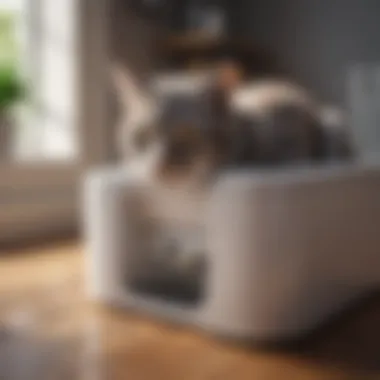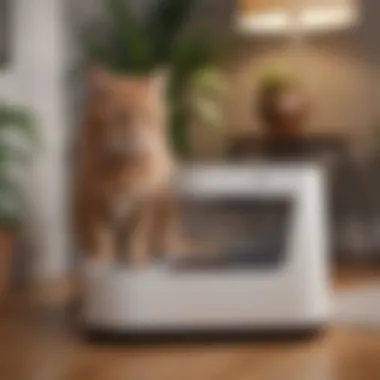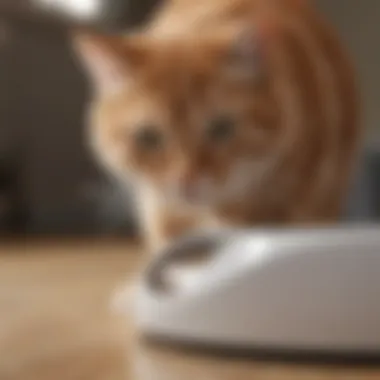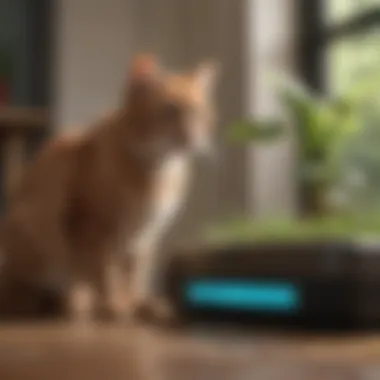Discover the Convenience of Robot Cat Litter Boxes on Amazon


Intro
In the realm of pet ownership, convenience often defines the relationship between animals and their caretakers. This article delves into the world of robot cat litter boxes available on Amazon. With the growing trend of automating daily chores, cat owners are increasingly considering these high-tech litter solutions. Through a meticulous evaluation of their functionality, benefits, and possible drawbacks, we aim to shed light on how these products can enhance pet care. The objective is to present a clear understanding of the options available, ensuring informed decisions for prospective buyers seeking efficient ways to manage their feline companions' needs.
Convenience of Automated Solutions
As technology advances, robotic solutions have found their niche in household management, especially in pet care. For cat owners, the routine task of cleaning the litter box can be a significant time sink. The shift towards robot cat litter boxes introduces a notable convenience factor. These devices automatically scoop waste, providing a cleaner and less odorous environment for both cats and their owners.
Many models also incorporate sensors, ensuring effective litter management based on the cat's usage. Thus, owners no longer have to worry about frequent manual cleaning, transforming a mundane obligation into a more manageable routine.
Key benefits of robot cat litter boxes include:
- Time-saving: Automation allows for more free time.
- Hygiene: Reductions in odors and maintenance needs.
- Health monitoring: Some designs track a cat's health through waste analysis.
However, it’s crucial to evaluate potential drawbacks to avoid disillusionment. Issues like noise, malfunctioning components, and initial costs can deter potential buyers.
Understanding Automated Options
Robot cat litter boxes come in various designs and features. The choices can be overwhelming, so understanding their functionalities is imperative. From basic to advanced models, options start with simple self-cleaning mechanisms and extend to those with Wi-Fi connectivity allowing remote management via smartphones.
Common features across brands include:
- Automated sifting and cleaning cycles.
- Use of different types of litter.
- App connectivity for monitoring.
Careful consideration of each feature in relation to specific needs ensures buyers choose the right product. Keep in mind the unique behavior and litter habits of your cat before making a purchase.
“Understanding the nuances of your pet's preferences is essential in selecting a robotic litter box. Not all cats will adapt seamlessly to changes in their environment.”
Ending
Robot cat litter boxes represent a significant innovation in pet care, catering to the needs of busy owners while addressing hygiene and maintenance. As technology permeates more aspects of daily life, these automated solutions bring practicality and convenience. By examining the various options available on Amazon, potential buyers can make informed choices tailored to their lifestyles, ensuring a positive experience for both themselves and their feline companions.
Preamble to Robot Cat Litter Boxes
Robot cat litter boxes have emerged as a significant advancement in pet care technology. Their growing popularity among cat owners reflects a shift towards convenience and efficiency in managing pet waste. The technology of these devices addresses several challenges cat owners face daily. These include the often unpleasant task of litter maintenance, concerns about hygiene, and the desire for a cleaner living environment for both pets and their families.
In this article, we will explore various aspects of robot cat litter boxes. Understanding their functionality, historical context, and market presence is essential for prospective buyers and enthusiasts of pet care technology. This section will provide foundational knowledge necessary for assessing whether these automated boxes are suitable for individual needs.
Defining Robot Cat Litter Boxes
Robot cat litter boxes are automated systems designed to clean litter after a cat uses it. These devices often feature a self-cleaning mechanism that sifts or scoops soiled litter into a waste compartment. They significantly reduce the manual labor involved in traditional litter management. Some models even connect to smartphone apps, allowing users to monitor their cat's bathroom habits and receive alerts when maintenance is needed.
The main driving force behind these products is the demand for enhanced convenience. Pet owners no longer need to scoop litter daily, which can be time-consuming and unpleasant. Additionally, a clean litter box helps maintain the cats’ health by minimizing exposure to bacteria and odors.
Historical Development of Automated Pet Care
The concept of automated pet care is not entirely new. Its origins can be traced back to simple mechanical devices. However, the development accelerated in recent years with technological advancements. Early iterations of automatic litter boxes emerged in the late 20th century, but they faced reliability and effectiveness issues.
As electronics and sensors improved, manufacturers began creating more sophisticated models. The introduction of smart technology into pet care devices has further enhanced their appeal. Today, robot litter boxes not only simplify the cleaning process but also cater to the growing environmentally conscious consumer base. Many brands now prioritize sustainability in their designs and materials. As a result, the focus has shifted from merely convenience to also encompassing health and environmental considerations in pet care.
The evolution of automated pet care underscores the potential impacts of technology on daily life, particularly in tasks once viewed as inherently laborious.
Through exploring these innovations, cat owners can better understand how shifting attitudes towards home care can lead to products that simplify responsibilities while maintaining the well-being of their pets.
Overview of the Market
Exploring the market for robot cat litter boxes offers significant insight into the evolving landscape of pet care technology. In recent years, there has been a noticeable shift towards automation in domestic settings, particularly in the care of pets. This shift highlights the growing need for convenience and efficiency in everyday tasks. Pet owners are increasingly seeking solutions that reduce time spent on maintenance, enhance overall hygiene, and offer peace of mind. Understanding this market is crucial for potential buyers as they evaluate not only their options but the specific advantages that these automated devices provide.


Current Trends in Cat Care Technology
The integration of technology into pet care has accelerated in recent times. Current trends reflect a move towards more sophisticated and user-friendly products that cater to the needs of both pets and their owners. Several key elements characterize this trend:
- Smart Features: Many robot litter boxes now include sensors that detect when a cat uses the box, automatically cleaning themselves shortly after.
- Mobile Connectivity: Certain models can connect to smartphones, allowing owners to monitor usage and receive alerts either through an application or via text.
- Eco-Friendly Materials: Increasingly, brands are aware of the importance of sustainability and are using biodegradable materials in their products.
These advancements represent a significant leap in how pet owners manage litter boxes. It reduces not only the physical effort needed for cleaning but also the time wasted on repetitive tasks. Moreover, these advancements enhance the welfare of pets by ensuring a clean environment.
Why Amazon Dominates Sales of Robot Litter Boxes
Amazon's position as a dominant force in the market of robot litter boxes can be attributed to various factors. First, the platform's extensive reach allows for a diverse range of products from multiple brands, catering to different consumer preferences. Additionally, Amazon provides detailed product descriptions, customer reviews, and ratings that help potential buyers make informed choices. These reviews serve both as guidance and social proof, influencing purchasing decisions based on shared experiences.
Furthermore, the convenience of shopping from home significantly boosts Amazon's appeal as many consumers prefer the ease of online shopping. Fast shipping options also contribute to immediate satisfaction post-purchase. This combination of variety, information, and convenience solidifies Amazon's standing as the go-to marketplace for people seeking robot cat litter boxes.
Key Features of Robot Cat Litter Boxes
The key features of robot cat litter boxes play a crucial role in their appeal. Understanding these elements can help prospective buyers see how these devices enhance pet care. Innovations in design and technology are essential for automating a task that many pet owners find tiresome. As the market continues to grow, distinguishing each feature's importance becomes vital for making an informed decision.
Autonomous Cleaning Mechanisms
Autonomous cleaning mechanisms are perhaps the most significant advantage of robot cat litter boxes. These systems are designed to conduct self-cleaning after each use, often within a few minutes. This feature reduces the manual effort required by pet owners, making litter maintenance far less cumbersome.
The cleaning process usually involves some form of rake or other moving component that collects used litter and deposits it into a sealed compartment. Many models allow users to customize cleaning schedules, providing flexibility based on cat habits.
Moreover, consistent cleaning can contribute to better hygiene for the pet. A clean litter box helps to prevent the growth of bacteria and parasites. This aspect is especially important for owners who might have multiple cats.
Odor Control Technology
Odor control technology is another critical feature of robot cat litter boxes. Cats are generally clean animals, and they are sensitive to smells. Therefore, effective smell management is essential for both the pet's comfort and the household environment.
Many robot litter boxes employ multiple methods to minimize odors. Some use advanced materials that help contain smells, while others feature filters that neutralize odors. Technologies like carbon filtration are common in many models. This ensures that the air remains fresh for both cats and their owners.
Additionally, some devices integrate odor-detecting sensors that can prompt the cleaning mechanism to activate when it detects specific smells. This innovation maintains cleanliness proactively rather than reactively.
Smart Technology Integration
Smart technology integration is transforming how pet owners interact with robot cat litter boxes. Many models come equipped with Wi-Fi connectivity and accompanying smartphone applications. This feature allows owners to monitor litter box activity remotely.
Users may receive alerts about the litter box's status, including when it needs to be emptied or maintained. This proactive approach to pet care enhances user experience by providing insights into cats' behaviors, like usage frequency.
In addition, some models offer reminders for litter change based on usage data. This information helps in maintaining optimal hygiene, ensuring the pet’s comfort.
The integration of smart technology in pet care devices represents a significant shift towards a more data-driven approach in enhancing pet well-being.
Overall, the key features of robot cat litter boxes provide a blend of convenience, hygiene, and technological advancement that can significantly improve pet ownership experience. By understanding these attributes, potential buyers can make educated choices that best meet their needs.
Benefits of Using Robot Cat Litter Boxes
The surge in demand for convenient pet care solutions underlines the significance of robot cat litter boxes. This segment of the article focuses on the multifaceted benefits that these automated systems bring not only to owners but also to the feline companions they serve. Analyzing the advantages of introducing these devices into daily routines can help prospective buyers make informed choices based on their specific lifestyle needs and their cats’ preferences.
Time-Saving Aspects
One of the most appealing benefits of robot cat litter boxes is the considerable time savings they offer. Traditional litter boxes require regular scooping and cleaning, which can become tedious for many pet owners. Robot litter boxes automate this process. Most models feature self-cleaning systems that detect when a cat has used the box and clean it shortly after.
- Quick Automation: Many devices can complete the cleaning cycle in a matter of minutes.
- Scheduled Cleaning: Some models allow users to schedule cleanings according to their preferences.
- Reduced Frequency of Full Cleanings: With automated systems, the need for frequent manual cleanings decreases.
By integrating time-saving technology, owners can focus more on enjoying quality moments with their pets rather than dealing with litter maintenance.
Enhanced Hygiene for Cats


Maintaining a clean environment is crucial for the health and well-being of cats. Robot litter boxes vastly improve hygiene in the litter area. They minimize the risk of bacterial growth and unpleasant odors, helping to keep both the space and the cats cleaner.
- More Frequent Cleanings: With automated features, waste is disposed of almost immediately.
- Proactive Odor Control: Many devices incorporate special coatings or materials that help to neutralize odors effectively.
- Less Contact with Waste: Robots can help reduce direct contact between hands and waste, lowering the chance of illness transmission.
This heightened level of cleanliness not only appeals to pet owners but also contributes positively to the cats’ overall health, reducing urinary tract infections and other litter-related issues.
Reduction in Smell and Mess
The inconvenience of lingering odors and litter scatter is a common complaint among cat owners. Robot litter boxes effectively tackle these issues through advanced design and technology.
- Fully Enclosed Designs: Many models feature lids or barriers that prevent litter from being kicked out.
- Sealed Waste Compartments: These compartments often trap odors effectively, helping maintain fresher air in the house.
- Usage of Clumping Litters: Most robot boxes are compatible with super absorbent clumping litters, which can contain smells better than non-clumping varieties.
The ability to significantly reduce unpleasant smells and mess makes these devices increasingly popular among owners who want a cleaner home.
Robot cat litter boxes not only promise convenience but also enhance the quality of life for both cats and their owners.
Challenges and Limitations
Understanding the challenges and limitations of robot cat litter boxes is crucial for potential buyers. While these devices offer various advantages, they are not without faults. Knowing about the downsides can assist users in making a more informed decision about whether to invest in such technology.
Initial Cost Considerations
One of the first factors to evaluate when considering a robot cat litter box is the initial investment. Prices can vary significantly, often ranging from $250 to over $600. This upfront cost can be daunting, especially when compared with traditional litter boxes, which can be acquired for $20 or less. However, it is important to weigh the costs against long-term benefits.
Restarting the cat litter box every week and purchasing litter can add up over time. Additionally, many users find that the convenience and time saved justify the initial expense. Nevertheless, budget-conscious consumers might find cheaper alternatives more appealing before committing to a robot option.
Technical Malfunctions and Maintenance
Technical issues are common in advanced technologies. Robot cat litter boxes are no exception. Users have reported malfunctions, such as the cleaning mechanism failing or the sensors misinterpreting the litter area. These problems can lead to a less efficient cleaning process, which in turn diminishes the system's overall purpose.
Maintenance is also a consideration. Many models require periodic cleaning of their compartments to ensure efficient operation. If maintenance is neglected, devices can accumulate litter waste, which may lead to unpleasant odors. Therefore, prospective buyers should consider not just the purchase price but also the necessary upkeep of the litter box.
Adaptation Issues for Some Cats
Another significant challenge is how some cats might react to the robot litter box. Pets can be creatures of habit, and sudden changes to their bathroom environment can cause stress and confusion. Some cats may refuse to use the new device altogether, preferring their traditional litter box.
To assist in the transition, pet owners may need to place the robot litter box alongside the old one for a period. Monitoring pet behavior during this phase is essential. It's also wise to select models that include features to help ease the adaptation process, such as those designed to mimic common behaviors of standard litter boxes. Not all cats will adapt seamlessly, and this might lead to accidents outside the box, which can further complicate matters.
Knowing the challenges of robot cat litter boxes helps in assessing their practicality against traditional options. This evaluation can guide pet owners toward making educated choices tailored to their pets' needs.
In summary, while robot cat litter boxes bring numerous conveniences, understanding their challenges and limitations can greatly inform a consumer's decision. The initial cost, potential technical issues, and adaptation concerns play a critical role in determining if such a product will fit well into a household's routine.
Comparative Analysis of Popular Brands
Understanding the various brands of robot cat litter boxes is crucial for making an informed purchase decision. The marketplace offers several options, each with unique features and benefits that cater to diverse user needs. A comparative analysis helps in evaluating these products on factors such as price, functionality, user experience, and maintenance requirements.
Litter-Robot Review
The Litter-Robot is often heralded as a leader in the automated litter box category. One of its distinguishing features is its self-cleaning capability, which uses a rotating mechanism to separate waste from clean litter. This process alleviates a significant part of the hassle of traditional litter boxes. The Litter-Robot also has a large waste drawer, reducing the frequency of emptying.
Many users appreciate the smart technology integration, which allows for notifications through an app. This feature keeps owners informed about litter levels and when it's time for a clean. But, it is worth noting that the Litter-Robot typically comes at a higher price point than others in the market, which may be a consideration for some buyers.
PetSafe ScoopFree Overview
PetSafe ScoopFree offers a unique approach with its disposable litter trays. This model utilizes crystals that absorb moisture and odor, minimizing the need for frequent changes. The automatic rake system collects waste into a covered trap. This reduces the visibility and smell of waste compared to standard litter boxes.
Users find that the low maintenance and ease of replacement are significant advantages. However, some reviews note that the initial cost of purchasing replacement trays can add up quickly, making long-term expenses a consideration.


CatGenie Insights
The CatGenie presents an innovative solution for cat owners looking for a litter-free environment. Instead of using traditional litter, it employs washable granules that get cleaned and dried with each use. The self-cleaning cycle uses water to handle waste, making it both environmentally friendly and low maintenance.
However, the need for a water line and drainage can pose installation challenges for some. The CatGenie also has a higher initial investment compared to its counterparts, which could deter some potential buyers. Yet users often report satisfaction with its performance, particularly in homes where odor control is a significant concern.
Comparison of Features and Prices
When exploring robot cat litter boxes, comparing features and prices amongst the popular brands is essential. Here's a concise breakdown:
| Brand | Key Features | Price Range | | Litter-Robot | Self-cleaning, smart alerts | $499 - $549 | | PetSafe ScoopFree | Disposable trays, crystal litter | $120 - $150 | | CatGenie | Washable granules, self-cleaning cycle| $249 - $299 |
Each of these brands brings its strengths and weaknesses to the table, impacting not just the product performance but also the user experience overall. Making an educated decision requires weighing these elements carefully.
"Choosing the right robot cat litter box hinges on understanding individual priorities like hygiene, convenience, and budget."
By scrutinizing different brands, potential buyers can evaluate which product aligns best with their lifestyle and their pets' needs.
User Experiences and Testimonials
User experiences and testimonials hold significant weight when it comes to evaluating robot cat litter boxes available on Amazon. They provide real-world insights and practical knowledge that can guide potential buyers in their decision-making process. Understanding how these devices perform in everyday situations can reveal both their advantages and limitations. Moreover, feedback from actual users can highlight features that may not be apparent in product descriptions.
When assessing the convenience of robot cat litter boxes, it is essential to consider aspects such as ease of use, effectiveness in odor control, and the overall satisfaction of pet owners. Reviews often include valuable information about installation, maintenance, and the adaptability of cats to these automated systems.
The opinions and ratings customers share can significantly impact potential buyers' choices. High ratings often correlate with satisfaction, while negative reviews can draw attention to issues that may not suit all households. Overall, this section aims to explore both the positive and negative experiences that users have reported, offering a balanced perspective on the effectiveness of robot cat litter boxes.
Positive Outcomes Reported by Users
Many users have praised the convenience of robot cat litter boxes. One of the most mentioned benefits is the amount of time saved on daily litter maintenance. Owners often share how automated systems significantly reduce the daily scooping or cleaning required.
Another common positive feedback centers around effective odor control. Several users note that their homes have become much fresher since implementing a robotic solution. Successful odor management can enhance the overall living environment for both cats and their owners.
Moreover, many cat owners appreciate the improved hygiene that comes with regular automatic cleaning cycles. This feature helps reduce the risk of health issues related to dirty litter boxes, which can be a concern particularly for elderly or immunocompromised cats.
In summary, positive outcomes from users typically focus on:
- Time savings due to self-cleaning capabilities
- Enhanced odor control, leading to a fresher home environment
- Improved pet hygiene associated with frequent cleaning routines
Common Complaints and Customer Feedback
Despite the numerous benefits, some users have encountered issues with their robot cat litter boxes. Complaints often arise regarding technical malfunctions. Some users reported that the system occasionally fails to clean effectively or becomes stuck during its cleaning cycle, requiring manual intervention.
Additionally, there are users who mention the initial setup as being more complex than expected. This feedback points to the learning curve associated with these advanced devices. Not all users find it intuitive to operate the technology, which can lead to frustration.
Another common concern is the adaptability of some cats to the robot litter box. Certain cats may be hesitant to use an automated system, especially if they are accustomed to traditional litter boxes. This can lead to behavioral issues if the pet refuses to use the new box, thus negating its intended convenience.
To summarize, common complaints include:
- Technical issues affecting cleaning efficiency
- Complicated setup and operation processes
- Reluctance from some cats to adapt to the robot litter box
Finale and Recommendations
As we reach the conclusion of our exploration into robot cat litter boxes, it is vital to summarize the key points discussed and provide actionable recommendations for potential buyers. Understanding both the benefits and challenges associated with these devices can greatly enhance the pet care experience.
Assessing Individual Needs Before Purchase
Before investing in a robot cat litter box, it is essential to assess individual needs and preferences. Every household has unique circumstances, and what works for one may not suit another. Here are a few considerations:
- Number of Cats: The type and number of cats in a household can significantly impact the choice. Units designed for multiple cats often have larger waste compartments and more robust cleaning mechanisms.
- Household Size and Layout: The space available for the litter box should be measured. Some models require more area for efficient operation, while smaller models may fit into tighter spaces.
- Cat Behavior: Some cats may require additional acclimatization to feel comfortable with automated litter boxes. Watching how a cat interacts with a device can inform the decision.
- Budget: Prices can vary widely, so establishing a budget is crucial. It is also important to factor in ongoing costs, such as special litter or maintenance materials.
Final Thoughts on Robot Cat Litter Boxes
In summary, robot cat litter boxes offer significant advancements in convenience and hygiene for pet owners. Their autonomous features can save time, while odor control technologies help maintain a fresher environment. However, the initial investment can be a substantial factor, and potential technical issues may arise over time.
When considering a robot litter box, users must weigh their specific needs against the benefits these devices provide. A thoughtful approach can lead to a more enjoyable pet care experience.







